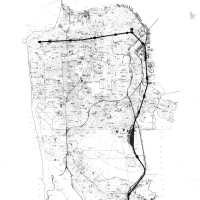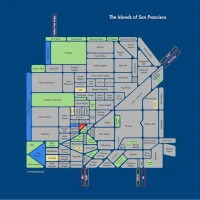Are We Too Civilized For Street Food? (And Why Mission Curves)
Plebiscite asks us these terrible questions:
- Is street food a positive byproduct of an underdeveloped infrastructure?
- Are we too civilized for a decent street food culture?
I am afraid the answer is yes, especially as he notes that “We’ll never have a legitimate street food culture in America so long as people are afraid of puking.” This is on top of the city permit impossibilities and turf wars between established vendors and upstart food carts.
He concludes:
Alas, I fear a complete socioeconomic collapse and reset might be the only road to American street food.
I guess this discussion is forced by the emergence of the fancy pants street cart, which some complain is itself an impediment to real street food culture. But I feel like the nuisance of the designer cupcake cart resolves itself in post-apocalyptal Street Food America, as the novelty of eating fancy food in non-fancy places fades away when there are no fancy places.
As we well may be on our way, it will be a good idea to make friends with your local street food vendors, neighborhood grocer and corner fruit dudes. (God knows Safeway will be completely useless. Hopefully Twitter will stay up or we will all starve to death.)
But not all news coming from Plebiscite is dire! His “inverted nachos” — parmesan crisp, roasted corn, jalapeño sour cream — will be making an appearance this Saturday at Mission Street Food.
Anyway, when the food-pocalypse arrives, I’ll be serving up the tomatoes, arugula and plums growing my yard (presuming I keep the animals at bay) and will be ready to trade as per historical precedent, as the Mission used to be the vegetable garden for San Francisco.
This account from 1859 gives an idea of the food traffic on the “Old Mission Road”.
On the Old Mission road, an omnibus passes and repasses fourteen times daily, with from 1 to 30 passengers, and will average 12 each way; leaving the Plaza on the even hour, from 7 O’clock, A. M., to 8 P. M. The San Jose stage, which leaves the Plaza at 8 A. M., and the Ocean House omnibus, which leaves the Plaza at 10 A. M., passes and repasses daily; the Overland Mail stage, via Los Angeles, which leaves the Plaza every Monday and Friday, at noon; is due, returning on the same day, but it generally arrives three or four days before time; Dorlin’s express runs twice a day to the Mission and back; in addition to these, there are 5 water carts, 10 milk, 12 meat, 18 bread, 40 vegetable, and from 20 to 30 express, or parcel wagons, daily.
This was the same “Old Plank Road” you can see on the 1853 Coast Survey Map, available from David Rumsey’s website. (This and Folsom, and various paths were how you got to the Mission in the 1850s.)
Mission Dolores, farms and a few beer gardens were big in our hood in the 1850s — most of the action was downtown. The 1853 Coast Survey map shows a clearly defined Market Street, with the built up part of the city pretty much stopping at Powell to the west and 5th to the south. Detail below:
You can see the Plank Road, curving to get through the hills and sand dunes that weren’t yet plowed over. Note the 60 to 80 foot sand dunes where Market St tapers out:
Here’s a view from the Rumsey collection looking south from down Mission at 9th, 1856, dunes aplenty.
So the Plank Road (and thus Mission today) curved to avoid the dunes, whereas Market St just stopped (until they were bulldozed out of the way). BART curves because of those sand dunes from 150 years ago. And I can jump on it and go to the Thursday Vendors Market at the ferry building to eat Mission based food like chiccarones! Plus ça change…













That’s a really sweet article. Dig the archives and maps, wow, I had no idea.
Thanks! You’ll probably like these posts, Mike:
https://burritojustice.wordpress.com/2009/01/29/mission-history-as-revealed-by-creeks-streams-lakes-and-lagoons/
https://burritojustice.wordpress.com/2009/01/30/ill-meet-you-at-valencia-and-falcon/
しっかりとした作りで、デザイン性にも優れていたのですが、何せ重くて結局手放すことになりました。